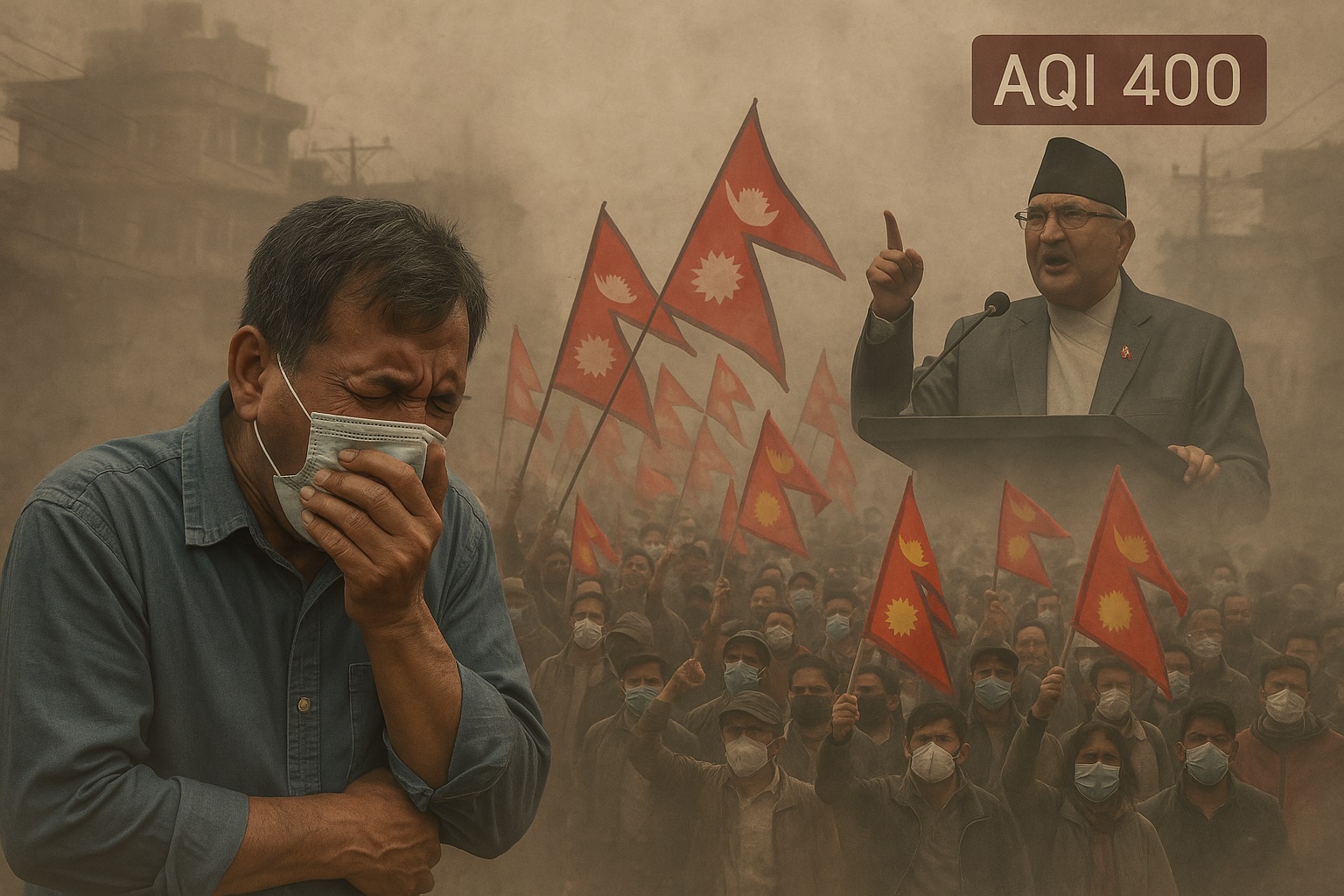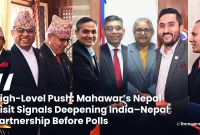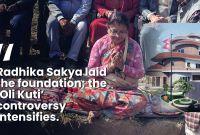Nepalis Can’t Breathe—And the PM’s Too Busy Battling Royalists!

As a suffocating blanket of toxic haze hangs over Kathmandu, the city’s residents are gasping for breath—literally. With Air Quality Index (AQI) readings routinely exceeding 300 and spiking as high as 400 in recent days, the capital’s air has turned into a silent killer. Burning eyes, persistent coughs, shortness of breath, and skin irritation are now everyday experiences. Yet while lungs collapse, the national debate has shifted to the streets—not in outrage over pollution or health, but in a political tug-of-war over the monarchy’s return.
While the Valley Suffocates, the Streets Chant for Kings
Across Kathmandu’s congested neighborhoods, throngs of protestors have gathered, waving royal flags and chanting slogans for the revival of the monarchy. This political energy, many observers argue, is tragically misdirected.
“It’s surreal,” said a schoolteacher from Kalanki, adjusting her mask while coughing. “We’re dying slowly here, and people are chanting for kings. What we need is clean air and clean governance.”
The Anatomy of a Crisis: Pollution’s Root Causes
Experts agree that the causes of Kathmandu’s dire pollution problem are both human-made and poorly regulated:
- Vehicular Emissions: An explosion in the number of poorly maintained, fossil fuel-powered vehicles.
- Brick Kilns: Dozens of traditional kilns around the valley belch black smoke.
- Construction Dust: Massive, unregulated construction projects leave the valley coated in fine particulates.
- Open Waste Burning: Household and industrial waste is frequently torched in the open, releasing harmful toxins.
- Transboundary Smoke: Wildfires in other regions, including India, funnel smoke into the valley.
Compounding these sources is the topography of Kathmandu—a bowl-shaped valley where pollutants get trapped. During thermal inversion, especially in winter and dry seasons, warm air layers cap the valley, sealing pollutants close to the surface.
According to ICIMOD, Kathmandu experienced polluted air for 75 of the past 90 days. As of this week, Shankapark recorded PM2.5 levels of 126.8 µg/m³ and AQI of 213—levels categorized as “very unhealthy.”
Waiting on the Monsoon—But It’s No Solution
The Department of Hydrology and Meteorology forecasts brief rains in the coming days, likely bringing temporary relief. However, environmental experts are unanimous: monsoon rains only wash away surface dust—they do not dismantle the systemic factors producing the smog.
Political Smokescreens: Government Priorities Questioned
While the air grows denser, critics accuse the government of misplacing its priorities. Prime Minister Khadka Prasad Oli’s administration is under fire for failing to enforce air quality regulations and for neglecting the 2076 Air Quality Management Plan, which classifies AQI above 300 as a public disaster.
Worse, allegations persist that elements connected to the ruling party have used affiliated “goons and dons” to disrupt or counter royalist protests. Though framed as efforts to control unrest, such actions have led many to question whether state power is being squandered on suppressing dissent rather than saving lives.
“It’s not just about kings versus republicans anymore,” said an environmental policy expert on condition of anonymity. “It’s about oxygen versus distraction. The government seems more invested in managing political narratives than tackling this life-threatening environmental emergency.”
Health Emergency in Slow Motion
Air pollution is now one of Nepal’s deadliest public health threats. According to the World Bank and WHO, exposure to high levels of PM2.5 is linked to:
-
Chronic respiratory illnesses
-
Cardiovascular disease
-
Increased child mortality
-
Significantly reduced life expectancy
Hospitals in Kathmandu report an uptick in pollution-related ailments. Flights have been delayed or grounded due to poor visibility. Yet public response remains fragmented and muted—overshadowed by protests on entirely different matters.
Toward Real Protests: Reclaiming the Right to Breathe
Doctors, scientists, and civil society leaders are now calling for a mass mobilization—not for or against the monarchy—but for the right to clean air, healthcare, and survival.
“What Kathmandu needs,” said a pulmonologist at Bir Hospital, “is a people’s movement demanding an end to the suffocation. This isn't about ideology—it’s about staying alive.”
Solutions Exist, But Require Political Will
Experts have outlined clear solutions to Kathmandu’s pollution:
-
Enforce vehicle emission standards and improve fuel quality.
-
Transition brick kilns to cleaner, energy-efficient technologies.
-
Regulate and control urban dust and construction activities.
-
Ban open burning and invest in proper waste management.
-
Expand electric public transportation.
-
Cooperate regionally on transboundary pollution monitoring.
But implementation remains the Achilles’ heel. Without public pressure and political accountability, even the best-laid plans collect dust like the roads of Kathmandu.
Conclusion: The Battle Worth Fighting
As the capital gasps beneath a noxious sky, it’s time for Nepal’s citizens to reorient their protest energy. The fight for monarchy or republicanism may shape the nation’s history—but the battle for clean air will determine whether its people get to live long enough to see it.
Until citizens demand breathable air, and until the government treats pollution as the health emergency it is, Kathmandu will remain a city under siege—not from kings or revolutionaries—but from the very air its people are forced to inhale.




![From Kathmandu to the World: How Excel Students Are Winning Big [Admission Open]](https://nepalaaja.com/index.php/img/70194/medium/excel-college-info-eng-nep-2342.jpg)
